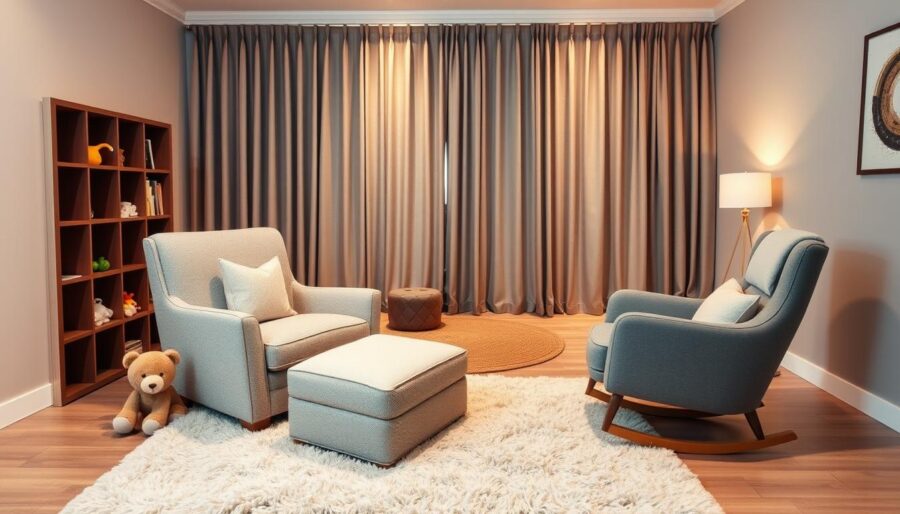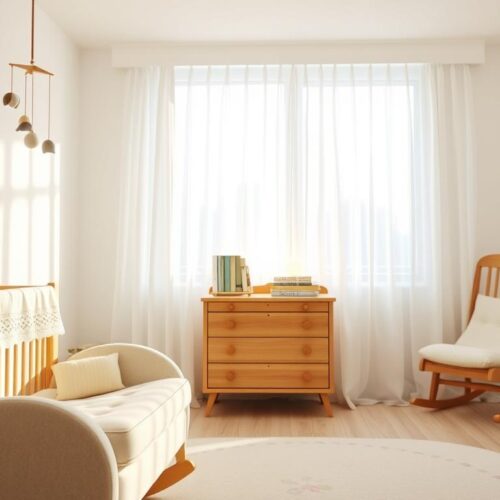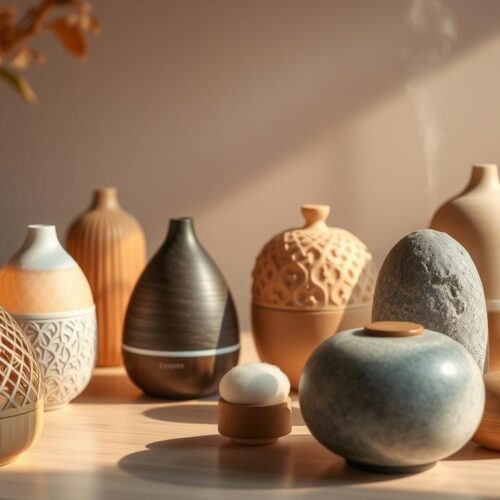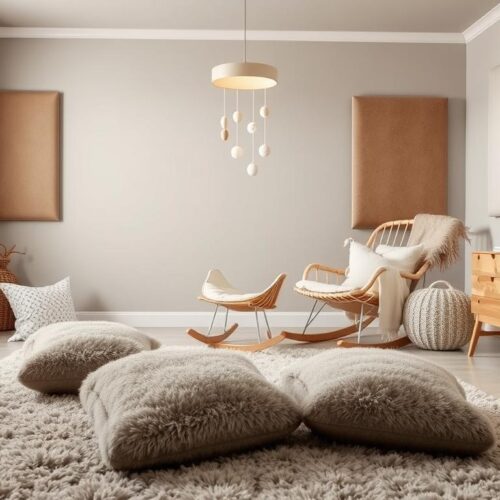Setting up a nursery means not just thinking about looks and function. It also means making sure it’s a calm place. Furniture that helps with sound can be key in making the room quiet and peaceful. This helps your baby sleep better and feel comfy. Let’s see how certain furniture can make a nursery feel calm and sound great.
Why Baby Room Acoustics Matter
A peaceful nursery is vital for your baby’s health. Good acoustic comfort in nurseries helps with sleep and calmness. Knowing how to manage sound means you can make a quiet space. This leads to better sleep for both babies and parents.
Too much noise can stress babies and mess up their sleep. Controlling sound reduces echoes and extra noise, making a calm atmosphere. This helps your baby feel safe and sleep more soundly.
A peaceful nursery environment also helps with feeding and playtime. It makes it easier for babies to get used to their surroundings and grow well. Focusing on acoustic comfort in nurseries creates a supportive space for your baby’s growth.
Choosing the Right Acoustic-Friendly Furniture
Finding the perfect acoustic-friendly furniture is key to a quiet baby nursery. You need to think about the materials and design for the best sound dampening. Chairs and ottomans that are soft can soak up more noise than hard surfaces.
Looking at a nursery furniture guide helps you understand which materials are good for sound. Fabrics like velvet and wool are great for absorbing sound. Picking furniture that also stores items can make the room quieter.
When setting up the best nursery, where you place furniture matters. Putting bookcases against the walls stops sound from echoing. Also, furniture with curved edges can break up sound waves, making the room more sound-friendly.
Choosing sound-friendly furniture for your nursery is smart. The right pieces will make a peaceful space for better baby sleep and happiness.
Types of Sound-Absorbing Furniture
Making a nursery quiet and peaceful can be tough. But, the right sound-absorbing furniture makes it easier. You can choose from upholstered chairs to bookcases that lower noise and look great in your nursery.
Upholstered chairs are great for a calm space. They’re covered in soft fabric that lowers noise. Adding a plush rug also helps by soaking up sound and making the nursery cozy.
Don’t forget about noise-reducing nursery furniture like bookshelves. They offer storage and block sound. Putting shelves against walls reduces noise. Add acoustic panels or curtains for an even quieter nursery.
There’s also acoustic furniture made for nurseries. For example, storage ottomans with cushions are both seating and sound-absorbers. Pick furniture that’s both useful and quiets the room.
Mix different sound-absorbing furniture for the best effect. A nursery with comfy chairs, bookshelves, and acoustic pieces will be quiet and stylish. It’ll be a peaceful spot for your baby.
Crib Selection for Better Acoustics
Choosing the right crib for your baby’s nursery is very important. It needs to support a calm atmosphere, considering acoustics. Cribs designed to optimize acoustics can lower noise, making the nursery quieter for sleep.
The crib’s materials and design affect how sound moves in the room. Wood cribs absorb sounds, reducing noise. Cribs with soft sides or fabric details can also make the nursery sound better.
It’s also key to think about where you place the crib. Keep it away from windows, doors, and areas with a lot of noise. Using a carpet or rug under the crib helps soak up sound, improving acoustics.
Here are some good choices for a nursery crib that’s friendly to sound:
| Crib Type | Material | Key Acoustic Feature |
|---|---|---|
| Wooden Crib | Solid Wood | Natural Sound Absorption |
| Upholstered Crib | Fabric and Wood | Padded Sides for Noise Dampening |
| Convertible Crib | Wood and Fabric | Versatile and Sound Buffering |
To sum up, finding the perfect crib means considering its materials, design, and where it’s placed. This helps make the nursery peaceful. By choosing a crib that’s good at quieting noise, you’re helping your baby sleep and feel better.
Using Rugs to Improve Baby Room Acoustics
Adding acoustic rugs to your baby’s room is a smart move. These thick, plush carpets absorb sound. They cut down echo, making a quiet space for your baby.
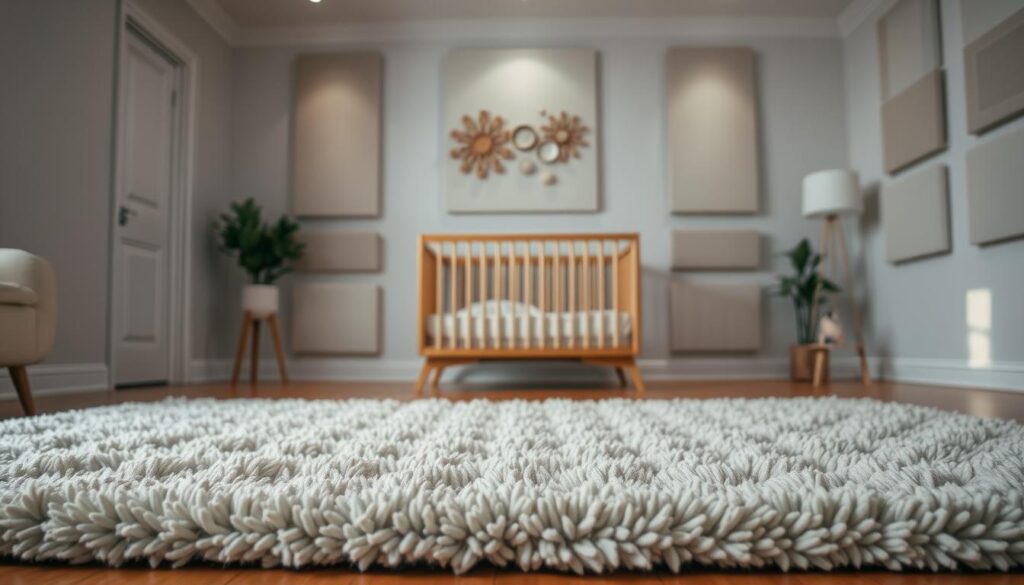
When choosing floor coverings for nurseries, think about what they’re made of and where to place them. Wool and shag rugs are top picks. Their dense fibers are great at muffling noise.
Put acoustic rugs by walls, under cribs, or in play spots to keep noise levels low. Layering smaller rugs can also make the room cozier and quieter.
Using carpet pads under your floor coverings for nurseries is another good idea. They give another layer of sound insulation. This makes the nursery even more peaceful.
Bookshelves for Sound Dampening
Bookshelves filled with books are not just for learning or looking nice. They also help make a room quieter. If you place them just right, they can make the sound in a nursery better. Try putting them against walls near loud areas to keep the noise down for your baby.
Bookshelves make a room nicer to look at too. Pick strong, good furniture to help with sound control. It’s best to have shelves full of books of all sizes. This helps sound be absorbed better and makes your nursery look great.
Think about how tall your bookshelves are and where to put them. Tall ones can block more sound, while short ones can fit into small spots. Being creative with where you put shelves can help a lot.
Here’s a quick comparison of what bookshelves are made of:
| Material | Sound Dampening Efficiency | Durability |
|---|---|---|
| Wood | High | Excellent |
| Metal | Medium | Good |
| Particle Board | Low | Average |
Picking the best material and placing your bookshelves wisely can make your nursery quieter. This makes a calm and happy space for your baby.
How Soft Furnishings Enhance Acoustic Comfort
Soft furnishings in nurseries do more than look nice. They help with the room’s sound quality too. Adding items like curtains, pillows, and blankets cuts down on echoes and softens noises.
Choosing the right materials is crucial for better acoustics. Use heavy curtain fabrics and thickly padded pillows. Thick, layered curtains block sound from hard surfaces. Plush pillows lower noise levels. Soft furnishings add both comfort and quiet to nurseries.
How you arrange these furnishings matters too. Cover whole windows with curtains. Use lots of pillows and blankets. These steps improve the room’s acoustics through textiles. They make a calm space for your baby.
Look for comfy, sound-friendly furniture too. Ottomans, upholstered chairs, and padded benches offer seating and reduce noise. They make the nursery more tranquil.
| Soft Furnishing Item | Material | Acoustic Benefit |
|---|---|---|
| Curtains | Heavy Fabric | Reduces echoes |
| Pillows | Dense Padding | Dampens Noise |
| Blankets | Thick Layers | Softens Sounds |
Furniture for Acoustic Comfort
Creating a calm nursery is key for your baby’s happiness and health. Adding furniture that improves sound quality is a smart move. By picking pieces that reduce noise, you make the nursery more soothing.
Some furniture is made to lower noise. Soft chairs absorb sound, making the room quieter. A glider with thick cushions, for instance, makes a big difference.
When designing a nursery, don’t forget about storage. Wooden bookshelves packed with books catch sound waves, cutting down echo and noise. Placing these items strategically enhances the room’s sound.
| Furniture Piece | Acoustic Benefits |
|---|---|
| Upholstered Chair | Absorbs ambient noise |
| Bookshelves | Reduces echo |
| Glider with Cushions | Enhances sound comfort |
Focus on acoustic design to make a peaceful nursery. Selecting the right sound-reducing furniture not only looks good but also makes the space quiet and cozy for your baby.
Multi-Functional Acoustic Furniture
When planning a nursery, think how multi-functional nursery furniture makes the space better. These pieces do more than one job. They also help absorb sound and reduce noise.
Look for versatile acoustic furniture like storage benches that also offer a place to sit. They cut down noise and keep things tidy. Space-saving acoustic furniture such as convertible cribs or foldable changing tables also make the room work better and sound nicer.
- Multi-functional nursery furniture helps you make the most of limited spaces while adding value to the acoustic environment.
- Opt for versatile acoustic furniture that includes built-in storage options for toys and essentials, which can also help muffle sound.
- Use space-saving acoustic furniture to keep the nursery clutter-free, which indirectly benefits the room’s acoustic properties.
Tips for Acoustic Design Solutions in Small Spaces
Designing small spaces can be tough, especially when you want good acoustics. To make a quiet space for your baby, it’s key to use sound solutions in compact areas. Here are a few acoustic tips for small nurseries to guide you.
Start by choosing furniture that can do more than one job and absorbs sound. Things like padded chairs or soft ottomans can help stop echoes and lower noise. Using these in designing small spaces boosts both use and sound quality.
Rugs and carpets are also great for making nurseries quieter. A thick rug can lessen noise and make the room feel cozy. Putting a rug under where your baby sleeps or plays can really help with noise.
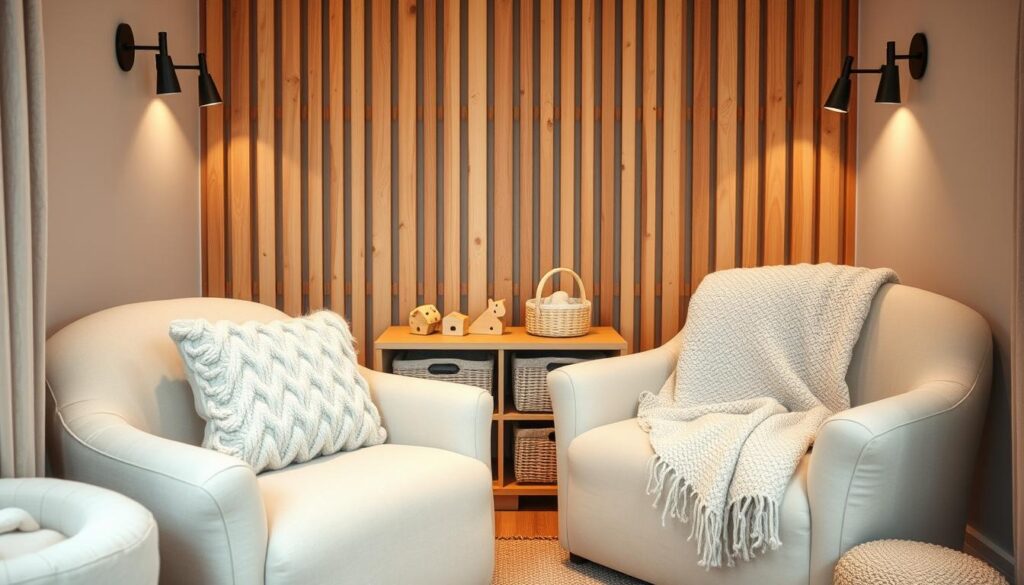
Don’t overlook the walls. Sound-absorbing panels or special wallpaper can cut down on noise. Choose materials made for soaking up sound for a quieter nursery.
Placing furniture smartly can help with noise too. Use bookshelves or units with soft fronts as noise blockers. Put these against walls you share with neighbors to lessen their noise, making sound solutions in compact areas more effective.
With these acoustic tips for small nurseries, you can make a space that’s not just pretty but calm for your baby. These smart moves will make sure your nursery is the best it can be for sound.
Acoustically Friendly Furniture for Small Nurseries
Making a small nursery calm is a challenge, but you can do it with the right furniture. Picking pieces designed for small nurseries can help keep things quiet. This lets your baby grow in a peaceful setting, even with not much room.
Think about furniture that has more than one use. A soft rocking chair, for example, is great for you and your baby. It’s comfy for feeding time and it cuts down on noise. Use padded storage options too. They’re handy and keep the nursery quiet.
Adding a crib with padded sides is smart. It’s cozy for your baby and helps with sound control. Wall-mounted bookshelves are good for saving space. They hold books and things that can soak up sound, making the nursery quieter.
Use your wall space wisely in a tiny nursery. Put up fabric art or tapestries. They look good and help with sound. An upholstered headboard can also absorb noise. It’s helpful if there’s a small bed in the room.
Rugs and soft mats make the nursery look nice and quiet down noises. Different textures on the floor help against hard surfaces. This creates a sound-friendly place in a small space. With these tips, your nursery will be a calm, functional spot for your baby.
How Storage Solutions Contribute to Room Acoustics
Well-planned storage solutions are vital for nursery acoustics management. They reduce noise and act as sound barriers. This creates a quieter, more serene space for your baby.
Using acoustic storage solutions is a smart move. They absorb and dampen sounds. The result? A softer, more comfortable atmosphere.
Think beyond conventional units. Add nursery storage for sound management. Soft toys and baskets in cubbies help absorb noise. This prevents sound from bouncing off hard surfaces.
Consider noise-reducing storage furniture too. Like upholstered benches that hide items. They also help absorb sound. This makes the environment quieter.
Choosing and placing acoustic storage solutions correctly is crucial. Smart storage in your nursery means a peaceful space. It’s where your baby can best thrive.
Integrating Play Areas with Acoustic Furniture
Creating play spaces in nurseries with good sound design is key to a calm atmosphere. Adding acoustic play furniture improves the look and keeps noise low, making the nursery less disruptive. This smart design choice makes sure kids have a space that’s fun and sounds good too.
Choosing sound-absorbing materials and designs is important for sound-friendly play areas. Foam mats, soft chairs, and padded playsets cut down on echo and noise. These choices help make a spot that’s good for both playing and quiet time, which is great for kids and parents.
Adding acoustic panels or baffles on the ceiling can improve sound absorption. These can look good and work well with the play area’s design. Choosing furniture that has more than one use, like storage and play areas, keeps things tidy and sounds better.
Bookshelves and storage units can also lower noise, acting as sound barriers. They offer practical storage and help with sound balance. By smartly adding these features, you can make a play area that’s fun and sounds comfortably quiet.
Personalizing Acoustic Furniture for Style and Functionality
Making a peaceful nursery is key for your baby’s comfort. Custom acoustic furniture offers both looks and usefulness. These pieces help control noise and become decorative highlights.
Adding stylish sound-absorbing furniture to your nursery improves it. It fits your decor while making the space quieter. Pick materials and colors that match your nursery’s theme.
For a unique nursery, go for custom pieces that show your style and meet sound needs. Choose from sound-absorbing panels, cozy furniture, or versatile acoustic items. The aim is to mix fashion with quiet.
| Furniture Type | Style Options | Acoustic Benefits |
|---|---|---|
| Acoustic Panels | Fabric, Art Print | Reduces Echo |
| Soft Furnishings | Velvet, Cotton | Absorbs Sound |
| Multi-Functional Pieces | Convertible, Storage Integrated | Dual Purpose |
Choosing custom acoustic furniture carefully makes a soothing nursery that shows your style. Pick pieces for their function and charm. This creates a perfect setting for your baby’s well-being.
Conclusion
Making your baby’s nursery quiet is key for a calm space. We talked about furniture that makes less noise. Picking a good crib and soft rugs helps manage sound in the room.
We pointed out how choosing the right furniture improves the nursery, not just by looking good but also by sounding better. Soft items like pillows, smart storage, and the right crib make the room feel nice and quiet. Even small rooms can sound great with the right furniture that serves many purposes.
In the end, a nursery is more than a pretty place. It should also be quiet for better sleep. By thinking about sound when designing, you make a peaceful spot for your baby. Good furniture helps your baby sleep well and stay happy.

